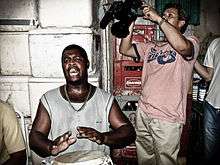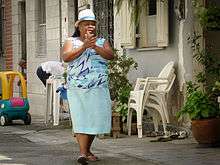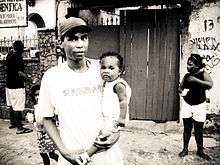Samba on Your Feet
| Samba On Your Feet | |
|---|---|
 Samba On Your Feet | |
| Directed by | Eduardo Montes-Bradley |
| Produced by | Soledad Liendo |
| Written by | Juan Trasmonte |
| Starring | Xangô da Mangueira, Tia Surica, Herminio Bello de Carvalho, Mart'nália, Paulo Barros, Teresa Cristina |
| Narrated by | Haroldo Costa |
| Music by | Caetano Veloso, Teresa Cristina, Mart'nália |
| Cinematography | Mustapha Barat |
| Edited by | Eduardo Montes-Bradley |
| Distributed by |
Heritage Film Project Alexander Street Press Filmakers Library |
Release date |
|
Running time | 60 minutes |
| Country | United States |
| Language |
Portuguese English subtitles |
Samba On Your Feet is a documentary film by Eduardo Montes-Bradley also known as "Samba! reflections of Africa in Brazilian culture”.[1] The film goes behind the scenes of Samba and Carnival to reveal the cultural and racial clash that gave birth to a new tradition in Rio de Janeiro.
Synopsis
In Samba On Your Feet (2006) the filmmakers go behind the Carioca milieu to document samba and carnival. The one-hour documentary traces the influences that contributed to shape the music that consecrated Carnival as one of the most powerful cultural manifestations in Brazil. Roots and perspectives, flesh and ghosts, entities and divinities spread across the slums and over the sidewalks of Salvador, Bahia and Rio de Janeiro are essential to the make-up of the Brazilian musical exponent par excellence[2]. Samba On Your Feet introduces the voices of Cartola, Caetano Veloso, Ismael Silva, Clara Nunes, Clementina and many others whose perspectives on the cultural affairs of Rio de Janeiro that have been carefully articulated with interviews to exponents of the Brazilian culture today. This dialogue between past and present takes place throughout the movie between precious scenes of archive footage from private collection, and government resources. Samba On Your Feet was mostly shot in the marginal slums, in the umbanda terreiros, in the favelas where the less fortunate inhabitants of Rio strive to overcome overwhelming rates crime and illiteracy to the rhythm and soul of the music they call samba.[3][4]
Samba On Your Feet has been invited to participate at the Toulouse Film Festival, France 2008; Rio International Film Festival, Brazil 2006; Buenos Aires Independent Film Festival (BAFICI) Argentina 2007; and Toronto Film Festival, Canada 2007. Samba On Your Feet is currently being screened at campuses throughout the US, and abroad.[5][6]
Crew and Credits
- Produced and directed by Eduardo Montes-Bradley
- Photography by Mustapha Barat
- Direct Sound by Bruno Fernández
- Written by Juan Trasmonte and Eduardo Montes-Bradley
- Edited by Eduardo Montes-Bradley
Cast


- Haroldo Costa. Historian, and writer. Costa has been involved in the cultural life of Rio de Janeiro since the early 1950s. He was better known as the protagonist of Orfeu da Conceição, a play by Vinicius de Moraes which paved the way for a Orfeu Negro (Black Orfeo). Today, Haroldo Costa is revered as one of the foremost authorities in Carioca folklore, with particular emphasis in Samba and Carnival.[7]
- Xangô da Mangueira. Singer and composer. Xangô is living whiteness to the times when Carnival, and Samba met for the first time in the streets of Rio de Janeiro.[8]
- Tia Surica (Iranette Ferreira Barcellos) (65). Active as a member of the Old Guard of her beloved Portela School of Samba. Her home, known as the "Cafôfo da Surica", is a fertile ground for musicians, and dancers seeking advice and support.
- Herminio Bello de Carvalho. Poet, producer, and composer. Herminio (70) is instrumental in understanding the movement known as MPB (Popular Music Of Brazil). His name is associated with the history of Cartola, Pixinguinha, Nelson Cavaquinho, Carlos Cachaça, Elton Medeiros, Mauricio Tapajós, and Clementina.
- Mart'nália. Singer and composer. Her name is referential to musicians in Europe and the US. She also is the daughter of legendary samba composer and singer Martinho da Vila.
- Paulo Barros. Carnivalesque. Paulo designs, and conceives the motive that will distinguish Unidos da Tijuca Samba School during the carnival. He organizes all creative aspects of parade and takes either credit fall for the success or failure of the escola. In the three years that Paulo has been leading Unidos da Tijuca he has transform carnival. In many ways, Paulo Barros is consider a revolutionary.
- Teresa Cristina. Singer. A true Carioca, "one that will sing with her eyes closed in front of a wild loving audience in the night clubs of Rio de Janeiro were everything smells of Samba and Cachaça".
- Mãe Helena D'oxsse. Priestess in the Umbanda tradition. She introduces samba in her extreme religious practices. Mãe lives in one of the poorest suburbs of Rio de Janeiro where she entertains lowlife and working class followers of Umbanda and Candomblé.
Festivals / Screenings
- Jefferson School African American Heritage Center. Charlottesville, VA. Conference-Screening. March 12.
- Brazil on the Beach, 2009[9]
- Toulouse Latin American Film Festival 2008
- Rio International Film Festival 2006
- Chicago Latino Film Festival
- Buenos Aires International Film Festival BAFICI 2007
- Toronto Latino Film Festival 2007
Distribution
The film is distributed by Alexander Street Press through the Academic Video Store, and Kanopy Straming .[10]
References
- ↑ University of Wisconsin-Madison Libraries. Catalogue reference.
- ↑ AfolabiIlê, "Niyi Aiyê in Brazil and the Reinvention of Africa", African Histories and modernities. p. 267 Palgrave Macmillian
- ↑ Filmmakers Library
- ↑ Janela Cultural. Joao Pessoa, Brazil
- ↑ Presented by Bloombars, in association with The Embassy of Brazil, the Instituto Camoes and the Washington Portuguese Language Meetup. On Thursday 2/14. Posted on Bloomscreen Indie Films, Film & Digital Arts.
- ↑ Distributed by Kanopy. Catalogued under Dance and Latin American Studies.
- ↑ Folha de Sao Paulo | Ilustrada. "Mostra reúne olhar gringo sobre o Brasil" by Luiz Fernando Vianna. September 25, 2005
- ↑ WTJU 91.1FM Interview with Eduardo Montes-Bradley | February 12, 2014
- ↑ The Art and Culture Center of Hollywood. Friday, March 20th, 2009
- ↑ Alexander Street Press. The Academic Video Store
External links
Citation and Selected Filmography
- Latin American Popular Culture Since Independence: An Introduction / edited by William Beezley and Linda Curio-Nagy - 2nd Edition p192
- Carnival in Brazilian Literature and Culture. University of Texas - Austin. Department of Spanish and Portuguese.